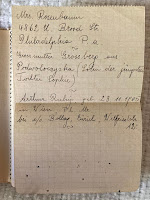I posted this last year when the Jewish calendar and the Gregorian date lined up almost perfectly. This year, the High Holidays were earlier this month so I decided to keep this as close to it's Gregorian date instead.
I’m taking a quick break from the boxes this week to talk about my mom’s side instead.
On her side, one of the stories that got passed down the generations was that Grandpa’s (my maternal grandfather’s) oldest sister died as a child. It was always told that she was the eldest child of her family and that she was either 7 or 9 when she died. Nobody ever knew what she died from. Her two brothers – both of whom grew up to be doctors – speculated decades later that she died from tuberculosis, like their father, but they weren’t sure.
A couple of times over the years I tried to find her death certificate. On the July 1912 immigration ship manifest with her mother and younger brother, it says her name was Rifka Zuljar. I tried searching for that. It didn’t work. I tried slight variations of her last name such as Zuliar and Zuler. Those didn’t work either.
Then I stumbled upon the Michiganology website. On a whim, I typed “Juliar” into the search bar of the Death Records 1897-1920 database thinking that the one death certificate I would find on there would be for Grandpa’s father. And there it was, above the name of Joseph Juliar (Grandpa’s father) (whom Mom and I call Joseph Zular to distinguish him from Grandpa).
Bekka Juliar. And a link to view the original certificate:
I was astounded. I couldn’t believe it! I had found her at last.
One of the first things I noticed was that the address was 426 Hastings St., Detroit, Michigan. This made perfect sense since her father died at the same address too. (It was where Grandpa’s father had a butcher shop.) Her age – 7 years, 5 months – threw me for a loop at the time. That didn’t make sense! She was listed as being 6 years old when she immigrated to America two years previously! How had she gained only 1.5 years in age over a 2+ year time span? However, I later realized that it could be because they didn’t know her exact age. This is because in those days, birthdays weren’t a big a big deal for Russian Jews. This also means – based on both the manifest and her death certificate – that she could’ve been born sometime between about the second half of July 1905 to April 1907. Which means that depending on when she was born, she could’ve been anywhere between age 7 and 9 when she died. And these are the two ages that are in the family lore. Which explains why nobody knew the exact age at her death.
Looking farther down the left-hand side of the death certificate, all of the birthplaces seemed correct – yes, as far as we know of, both Rifka and her parents were born in the Russian Empire, and her father’s name was correct too. However, her mother’s name made me pause. The death certificate says her name is Seiga Lingerman. It’s actually Feiga Singermanso something got lost in the translation or misheard or misunderstood somewhere. (By the way, I have never heard of the informant’s – H. Foreman’s – name before.)
On the right-hand side, it says that she died on September 28, 1914. That got me thinking. The High Holidays (Rosh Hashanah (the Jewish New Year) and Yom Kippur (the Day of Atonement)) always fall sometime between early September and mid-October depending on the year. Did she die around the High Holidays? Actually she did:
The 10 Tishrei is Yom Kippur day but like all Jewish holidays it starts the night before. Looking at the death certificate more closely, we see that she was buried the next day (29 September). This means that within hours of her funeral, her parents and siblings at least possibly, if not probably, had to go to synagogue for the Kol Nidre service (the first service of Yom Kippur) and her parents had to start a 25-hour fast if they were medically able to.
It’s just astounding to me to think of the suddenness of life. Rifka – Bekka – Juliar was alive and presumably healthy on Rosh Hashanah. By Yom Kippur, she was dead.
That’s only a ten day difference.
According to Mom – and this was in the 1950s! – she remembers attending Yom Kippur services with her paternal grandmother and during one of the confessionals, her grandma would cry as she beat her chest. For years I thought it was because her grandma was very religious so she was crying because she was thinking of all the bad things she had done wrong over that past year. Since finding that death certificate though, I’m now wondering if part of it had to do with grieving the death of her first-born child.
We will never know for certain.
If you observe Yom Kippur (which starts tonight), may you be written in the Book of Life and if not, have a great Sunday.





















